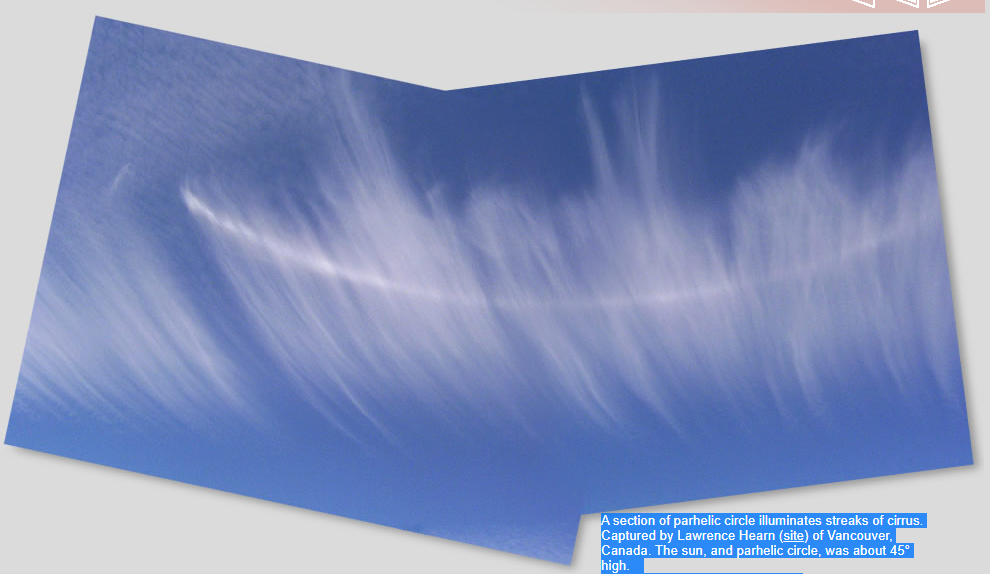Parhelic circle in cirrus streaks
Parhelic Circle in Cirrus Streaks: A Mesmerizing Atmospheric Phenomenon
When it comes to atmospheric optics, nature has a way of captivating us with its awe-inspiring displays. One such phenomenon that often leaves observers spellbound is the parhelic circle in cirrus streaks. This mesmerizing occurrence occurs when a section of the parhelic circle illuminates streaks of cirrus clouds, creating a truly breathtaking sight. In this article, we will delve into the intricacies of this phenomenon, exploring its causes, characteristics, and the science behind its formation.
Understanding the Parhelic Circle
Before we dive into the specifics of the parhelic circle in cirrus streaks, let's first understand what the parhelic circle is. The parhelic circle is an optical phenomenon that manifests as a faint white halo encircling the Sun at the same elevation as the Sun itself. It forms when sunlight passes through ice crystals present in the atmosphere, such as those found in cirrus clouds. These ice crystals act as tiny prisms, refracting and reflecting sunlight to create an array of captivating optical effects.
Cirrus Streaks: A Beautiful Canvas for the Parhelic Circle
Cirrus clouds, with their delicate and wispy appearance, provide the perfect canvas for the parhelic circle to showcase its brilliance. These high-altitude clouds consist of thin, elongated ice crystals that are often aligned horizontally. When sunlight interacts with these ice crystals, it gives rise to an enchanting display of light and color. The parhelic circle, in particular, finds its place in this celestial spectacle, casting its ethereal glow upon the cirrus streaks.
The Science Behind the Phenomenon
The formation of the parhelic circle in cirrus streaks can be attributed to a combination of factors involving sunlight and ice crystals. As sunlight passes through the ice crystals in cirrus clouds, it undergoes refraction, causing the light to bend. The refracted light then reflects off the crystal faces, creating a multitude of rays that spread out in a circular pattern around the Sun. This dispersion of light forms the parhelic circle, which appears as a continuous band of light encircling the Sun.
The Role of Ice Crystal Orientation
The orientation of the ice crystals within the cirrus clouds plays a crucial role in the appearance of the parhelic circle in cirrus streaks. When the ice crystals align horizontally, as is often the case with cirrus streaks, the parhelic circle becomes more pronounced. This alignment allows for a greater number of ice crystals to interact with sunlight, resulting in a more vivid and defined display of the parhelic circle.
Other Associated Optical Phenomena
While the parhelic circle takes center stage in this atmospheric display, it is not the only optical phenomenon that can be observed in conjunction with cirrus streaks. Other related phenomena include:
- Circumzenithal Arc: A vivid arc of colors that appears above the Sun, resembling an upside-down rainbow.
- Upper Tangent Arc: A bright arc of light that intersects the parhelic circle at its uppermost point.
- Lower Tangent Arc: Similar to the upper tangent arc, but appearing at the lowermost point of the parhelic circle.
- Supralateral Arc: A faint arc that extends horizontally from the parhelic circle, forming a parallel line.
- Parry Arc: A short arc that intersects the parhelic circle at a steep angle.
These additional optical phenomena add to the enchantment and complexity of the overall atmospheric display.
Capturing the Parhelic Circle in Cirrus Streaks
To witness and capture the parhelic circle in cirrus streaks is a truly rewarding experience for any sky enthusiast or photographer. The best conditions for observing this phenomenon are when the Sun is relatively high in the sky, typically around 45° or more. The presence of cirrus clouds, particularly streaks with horizontally aligned ice crystals, enhances the chances of witnessing this ethereal display.
When photographing the parhelic circle in cirrus streaks, it is important to consider the positioning of the Sun and the composition of the shot. Experimenting with different camera settings, such as exposure and focal length, can help capture the intricacies and beauty of this celestial phenomenon. Patience and perseverance are key when attempting to photograph these elusive atmospheric displays.
Unveiling the Mysteries of the Sky
The parhelic circle in cirrus streaks is a captivating testament to the wonders of our atmosphere. As we continue to explore and unravel the mysteries of the sky, these mesmerizing optical phenomena serve as reminders of the intricate interplay between light, ice crystals, and the ever-changing canvas of our atmosphere. So next time you find yourself gazing at the sky, keep an eye out for the parhelic circle in cirrus streaks, and allow yourself to be captivated by the magic that unfolds above.

A section of parhelic circle illuminates streaks of cirrus. Captured by Lawrence Hearn (site) of Vancouver, Canada. The sun, and parhelic circle, was about 45° high.
©Lawrence Hearn, shown with permission.
Note: this article has been automatically converted from the old site and may not appear as intended. You can find the original article here.
Reference Atmospheric Optics
If you use any of the definitions, information, or data presented on Atmospheric Optics, please copy the link or reference below to properly credit us as the reference source. Thank you!
-
<a href="https://atoptics.co.uk/blog/parhelic-circle-in-cirrus-streaks/">Parhelic circle in cirrus streaks</a>
-
"Parhelic circle in cirrus streaks". Atmospheric Optics. Accessed on November 26, 2024. https://atoptics.co.uk/blog/parhelic-circle-in-cirrus-streaks/.
-
"Parhelic circle in cirrus streaks". Atmospheric Optics, https://atoptics.co.uk/blog/parhelic-circle-in-cirrus-streaks/. Accessed 26 November, 2024
-
Parhelic circle in cirrus streaks. Atmospheric Optics. Retrieved from https://atoptics.co.uk/blog/parhelic-circle-in-cirrus-streaks/.